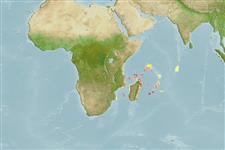Classificação / Names
Nomes comuns | Sinônimos | Catalog of Fishes(Gênero, Espécies) | ITIS | CoL | WoRMS | Cloffa
>
Blenniiformes (Blennies) >
Blenniidae (Combtooth blennies) > Salariinae
Etymology: Entomacrodus: Greek, ento = inside + Greek, makros = big + Greek, odous = teeth (Ref. 45335); lemuria: Named after Lemuria, a hypothetical continent, supposed to exist in the Indian Ocean and now represented by Madagascar and some adjacent islands.
More on authors: Springer & Fricke.
Environment: milieu / climate zone / depth range / distribution range
Ecologia
marinhas demersal; intervalo de profundidade 0 - 5 m (Ref. 40894). Tropical
Western Indian Ocean: Madagascar, Mauritius, and Reunion.
Tamanho / Peso / Idade
Maturity: Lm ? range ? - ? cm
Max length : 6.8 cm SL macho/indeterminado; (Ref. 40894)
Descrição suscinta
Chaves de identificação | Morfologia | Morfometria
Espinhos dorsais (total) : 13 - 14; Raios dorsais (total) : 14 - 17; Espinhos anais: 2; Raios anais : 16 - 17. Ventral margin of upper lip crenulate on lateral thirds; entire on central third; nape cirri present, simple; orbital cirri branched; 1 to 5, usually 3 to 5, preopercular pore positions with pairs or multiples of pores; subquadrate dark blotch present in humeral area on body; upper lip frequently with up to 15 alternating dark and 15 pale bands of subequal width, up to 7 of each above central, ventrally entire portion of lip; prominent, irregular dark mark on head just posterior to midpostorbital sensory pores.
Facultative air-breathing in the genus (Ref. 126274); Oviparous. Eggs are demersal and adhesive (Ref. 205), and are attached to the substrate via a filamentous, adhesive pad or pedestal (Ref. 94114). Larvae are planktonic, often found in shallow, coastal waters (Ref. 94114).
Ciclo de vida ou comportamento de acasalamento
Maturidade | Reprodução | Desova | Ovos | Fecundidade | Larvas
Oviparous, distinct pairing (Ref. 205).
Springer, V.G. and R.A. Fricke, 2000. Description of two new blenniid fish species: Entomacrodus lemuria from the western Indian Ocean and E. williamsi from the western Pacific Ocean. Proc. Biol. Soc. Wash. 113(2):386-396. (Ref. 40894)
Status na Lista Vermelha da UICN (Ref. 130435: Version 2024-2)
Ameaça para os humanos
Harmless
Uso pelos humanos
Ferramentas
Relatórios especiais
Baixar XML
Fontes da internet
Estimates based on models
Preferred temperature (Ref.
123201): 25.4 - 28.4, mean 27.5 °C (based on 166 cells).
Índice de diversidade filogenética (Ref.
82804): PD
50 = 0.5000 [Uniqueness, from 0.5 = low to 2.0 = high].
Bayesian length-weight: a=0.01047 (0.00461 - 0.02381), b=2.98 (2.79 - 3.17), in cm total length, based on LWR estimates for this (Sub)family-body shape (Ref.
93245).
Nível Trófico (Ref.
69278): 2.0 ±0.00 se; based on food items.
Resiliência (Ref.
120179): Elevada, tempo mínimo de duplicação da população menor que 15 meses (Preliminary K or Fecundity.).
Fishing Vulnerability (Ref.
59153): Low vulnerability (10 of 100).
